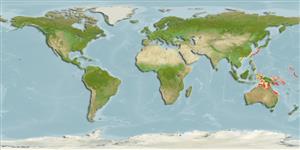>
Gobiiformes (Gobies) >
Gobiidae (Gobies) > Gobiinae
Etymology: Trimma: Greek, trimma, -atos = something crushed (Ref. 45335); readerae: Named for Sally Reader, Australian Museum..
Environment: milieu / climate zone / depth range / distribution range
Οικολογία
Θαλασσινό(ά) Υφαλόφιλο(α); εύρος βάθους 0 - 40 m (Ref. 100726). Subtropical
Κατανομή
Χώρες | Περιοχές FAO | Οικοσυστήματα | Παρουσίες | Point map | Εισαγωγές | Faunafri
Western Pacific: known from mid to outer reefs on the Great Barrier Reef, and inshore reefs of Western Australia, but rarely from the Coral Sea and Timor Sea. Tentatively included, in what appears to represent a species complex, specimens and images collected from the Solomon Islands, Indonesia, Borneo, New Guinea, Japan and the Marshall Islands (also based on the spotting pattern on the cheek).
Μέγεθος / Βάρος / Age
Maturity: Lm ? range ? - ? cm
Max length : 2.6 cm SL αρσενικό/απροσδιόριστο; (Ref. 100726); 2.3 cm SL (female)
Short description
Μορφολογία | Μορφομετρία
Ραχιαίες άκανθες (συνολικά): 7; Μαλακές ραχιαίες ακτίνες (συνολικά): 8-10; Εδρικές άκανθες 1; Μαλακές εδρικές ακτίνες: 8. This species is distinguished by the following characters: adults with a moderately deep interorbital trench and a shallow groove behind the upper half of the eye, largely disappearing below the papilla at the posterodorsal margin of the eye; predorsal is almost completely covered with ctenoid scales, with 3-6 rows crossing the midline anteriorly to just behind the interorbital trench, anterior-most scale on the midline just behind a small naked patch posterior to the eyes, the scale not larger than the second scale on the midline; no scales on opercle and preopercle; pectoral-fin base is covered with 5-6 large cycloid scales, lowermost 3-4 scales smaller than upper two scales; prepelvic area with a small scale covering basal membrane between the two fins and followed anteriorly by a large scale between the bases of fins, and 3 rows of large cycloid scales anteriorly; central pectoral rays are branched; pelvic fins are widely separate, connected only at their bases, the distance between the bases of the fins about three-quarters to equal to the base of each pelvic fin; the fifth pelvic ray is usually unbranched, rarely with a single branch (2 terminal tips); fifth ray 60-80% the length of the fourth; the second dorsal spine usually longest, elongated into a long filament in adult males, reaching to beyond the end of the second dorsal fin, while females sometimes with a short filament reaching to above the anterior rays of the second dorsal fin; the third spine sometimes a short filament; D2 usually I 9 and anal rays usually I 8; below the eye are two distinct round red to reddish-orange spots; the branchiostegal membranes with distinct bright reddish-orange spots; body possess small yellow to red spots in 4-5 irregular rows anteriorly and three rows on the caudal peduncle (Ref. 100726).
This species is usually found in back reef leeward areas (Ref. 100726).
Life cycle and mating behavior
Γεννητική Ωρίμανση | Αναπαραγωγή | Γεννοβολία | Αβγά | Γονιμότητα | Προνύμφες
Winterbottom, R. and D.F. Hoese, 2015. A revision of the Australian species of Trimma (Actinopterygii, Gobiidae), with descriptions of six new species and redescriptions of twenty-three valid species. Zootaxa 3934(1):001-102. (Ref. 100726)
IUCN Red List Status (Ref. 130435)
Threat to humans
Harmless
Human uses
Περισσότερες πληροφορίες
ΧώρεςΠεριοχές FAOΟικοσυστήματαΠαρουσίεςΕισαγωγέςStocksΟικολογίαΔίαιταΤροφικά αντικείμεναΚατανάλωση τροφήςΣιτηρέσιο
Κοινά ονόματαΣυνώνυμαΜεταβολισμόςΘηρευτέςΟικοτοξικολογίαΑναπαραγωγήΓεννητική ΩρίμανσηΓεννοβολίαΣυναθροίσεις γεννοβολίαςΓονιμότηταΑβγάEgg development
Age/SizeΑύξησηLength-weightLength-lengthLength-frequenciesΜορφομετρίαΜορφολογίαΠρονύμφεςΔυναμική προνυμφώνΣτρατολόγησηΑφθονίαBRUVS
ΑναφορέςΥδατοκαλλιέργειεςΠροφίλ υδατοκαλλιέργειαςΣτελέχοιΓενετικήElectrophoresesΚληρονομικότηταΑσθένειεςΜεταποίησηNutrientsMass conversion
ΣυνεργάτεςΦωτογραφίεςStamps, Coins Misc.ΉχοιΣιγκουατέραΤαχύτηταΚολυμβητικός ΤύποςΕπιφάνεια βραγχίωνOtolithsΕγκέφαλοιΌραση
Εργαλεία
Special reports
Download XML
Διαδικτυακές πηγές
Estimates based on models
Phylogenetic diversity index (Ref.
82804): PD
50 = 0.5000 [Uniqueness, from 0.5 = low to 2.0 = high].
Bayesian length-weight: a=0.01023 (0.00477 - 0.02194), b=3.02 (2.84 - 3.20), in cm total length, based on LWR estimates for this (Sub)family-body shape (Ref.
93245).
Ελαστικότητα (Ref.
120179): Υψηλό, ελάχιστος χρόνος για διπλασιασμό πληθυσμού < 15 μήνες (Preliminary K or Fecundity.).
Fishing Vulnerability (Ref.
59153): Low vulnerability (10 of 100).
